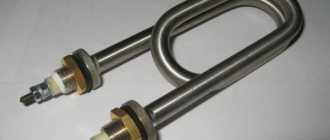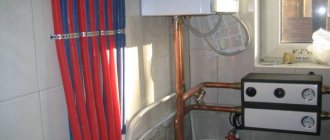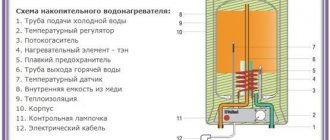The difference between a boiler and a water heater
Modern man is accustomed to comfort. The expression “comfort in the yard” has already become humorous, and people strive to surround themselves with comfort, organize the surrounding space in such a way as to feel as comfortable as possible in their house or apartment. One of the main conditions for comfort is the constant availability of warm water. In addition to centralized supply, which is burdened with many disadvantages, hot water can be obtained from a boiler or water heater.
The water heater must be installed in a spacious, easily accessible location.
What is a boiler?
It is a container filled with water heated by a heat source.
In other words, this is a storage type water heater, that is, stored water is heated, not running water.
Load on the electrical network
The differences between a boiler and a water heater include, but are not limited to, significant differences in power consumption.
Flow heater
The minimum electrical power of the device is 3.5 kilowatts. Just such a device – Atmor Basic – is installed in my attic bathroom. The power consumption allows you to connect it to a regular European socket.
Attention: to avoid overheating, hidden wiring should be calculated based on a maximum current of 8 amperes per square millimeter of copper wire cross-section. If so, for a current of 16 amperes, corresponding to a consumption of 3.5 kW, you need wiring with a cross-section of at least 2 mm2.
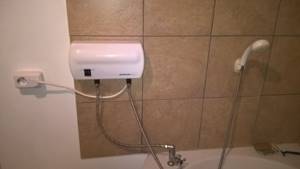
A 3.5 kW appliance can be plugged into a wall outlet, but has strict wiring requirements.
The maximum power of commercially available electric flow heaters is 24 kW. They are connected only with a separate cable thrown from the panel, and only to networks with a voltage of 380 volts.
Gas appliances, for obvious reasons, are undemanding when it comes to wiring: the required power consumption is provided by the burner.
However, their operation requires compliance with certain safety measures:
- Installation is only possible in a room with its own ventilation duct;
- The device needs a constant flow of fresh air into the room where it is installed.
Boiler
The typical power of an electric boiler is from 1.3 to 2 kW.
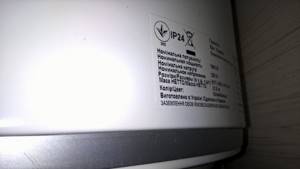
The power of my boiler is 1.5 kilowatts.
It can be connected to any electrical outlet with a wire cross-section of 1.5 mm2. Connecting via an extension cord is not advisable, but is possible if absolutely necessary.
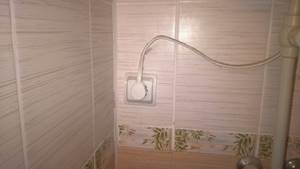
The photo shows a socket for connecting a boiler.
Types of boilers that exist today
The main types according to the method of heating water:
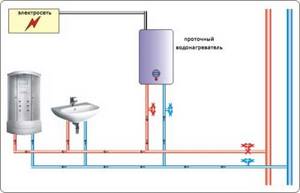
Installation diagram of instantaneous water heater.
- electrical;
- gas: with an open combustion chamber (using natural draft); with a closed combustion chamber (using forced draft);
- indirect heating (those that use boiler power);
- combined - using gas and electricity.
According to the method of water supply:
- pressure;
- non-pressure (can be used in the absence of running water).
By installation method:
- floor;
- suspended (divided into vertical and horizontal).
According to the shape of the tank:
- round (cylindrical);
- oval (in the shape of an oval rectangle);
- other forms.

Indirect heating boiler diagram.
An electric boiler consists of a metal tank, a heating element (thermal electric heater), a magnesium anode and a thermostat. The magnesium anode serves to protect against corrosion inside the tank. The outside surface of the tank is covered with a layer of heat-insulating material. Depending on the model, additional elements may be present.
Operating principle: A heating element placed inside the tank heats the water. Cold water is supplied from below, hot water is discharged from above. The pressure in the water supply system pushes out the heated water, and it flows to the points of use. The thermostat controls the water temperature (the user sets this parameter himself, changing if necessary), heating the water to the set value and maintaining the temperature by turning the heating element on and off.
Related article: How to plaster walls under wallpaper with your own hands: materials and technique
The advantages of an electric water heater are: lower cost, ease of installation, no need for a chimney, the ability to install in any convenient place, even under the ceiling (suspended horizontal boilers are designed specifically for this).
An electric boiler is connected to a household electrical network, so it is convenient to use it in a house, apartment, country house, or in small enterprises for domestic purposes.
Gas boiler. The principle of operation is the same as that of an electric one, only the water is heated from a gas burner.

Electrical diagram for connecting the boiler.
To install it, you need to make an additional exit into the chimney, and this complicates installation and affects the location of the device. A boiler with a closed combustion chamber (using forced draft) can be installed against an external wall with combustion products discharged through a special hole in it.
Advantages: with a higher purchase and installation cost, a gas boiler is cheaper during operation, since the price of gas is much lower than that of electricity. Another advantage is greater power compared to electric ones. This allows you to quickly heat the water to the desired temperature, so you can purchase a slightly smaller boiler for the same needs. Disadvantages: arbitrary placement is impossible, additional documentation is required for installation, and the main thing is that gas is not available everywhere.
Indirect heating boiler. Can be an addition to a single-circuit boiler. The cylinder-shaped container can be installed vertically or horizontally depending on the model. A heat exchanger pipe is placed inside the container, which has a complex shape (usually serpentine). A coolant circulates through this pipe, which heats the water.
There are models without heat exchanger tubes. Such a boiler consists of two vessels inserted into one another. The inner vessel contains heated water, and the coolant circulates in the outer vessel.
Operating principle: cold water enters the boiler tank through the inlet; a coolant fluid, heated by the heating boiler, circulates in the heat exchanger coil or between the double walls of the housing. It heats the incoming water in the boiler and maintains it at a constant temperature. Each indirect heating boiler has inlet and outlet pipes connecting it to the heating boiler, and hot water flows to the consumer through the outlet pipe.
Related article: Bypass in electrics, what is it?
Advantages:
- high performance;
- the coolant fluid is specially prepared, thereby reducing its negative impact on the heat exchanger;
- you can use various sources of thermal energy, and also switch from one to another if necessary (there are models of boilers with a built-in heating element).
Flaws:
- high cost of equipment and installation (requires invitation of specialists);
- when heating a large volume of water, less heat is supplied for heating;
- installation must be carried out in a special room (boiler room).
Price
At the time of purchase, the price of the heaters installed in my house was:
- Flow-through Atmor - about 2000 rubles;
- Storage Atlantic with a tank of 80 liters - about 6,000 rubles.
Prices have increased slightly since then, but the trend continues today: the boiler is noticeably more expensive.
In the upper price category there are combined boilers - water heaters with a tubular heat exchanger, which allows you to connect the device to the heating network as an indirect heating boiler, and a heating element to maintain the temperature at peak load or when the heating boiler is turned off. In this category, prices start from 27 - 30 thousand rubles.
Instantaneous water heaters - columns
The design and operating principle of these devices is somewhat different from storage devices. In flow-type heaters, water is heated not in a container, but by flowing through a heating element. The heating element can be a gas burner, a heating element or a non-insulated coil. It is clear that the water heats up in a matter of seconds, and its volume is not limited by the capacity of the tank. As soon as the tap opens at the water intake point, the water heater automatically turns on and water heating begins.
Such water heaters can be open (non-pressure) or closed (pressure). Non-pressure ones can only work with output to one mixer, and pressure ones can work for several water flow points.
Non-pressure water heaters must be equipped with special mixers, but their installation is very simple, and equally simple dismantling is possible. The advantage is low cost. Therefore, it is better to use them as a seasonal water heating device or in adapted premises, for example, in a country house.
Most popular models
The store offers a lot of models of water heaters and boilers, but among all the offers there are the best models, according to experts and buyers. Among water heaters and boilers, there are 5 models suitable for different categories of consumers.
Electrolux EWH 100 Royal
An expensive boiler model is equipped with many different protection options. The storage system can collect and heat 100 liters. The device is equipped with several directions of water output, has a built-in display and allows mechanical control of built-in functions. As protection, the boiler is equipped with a safety and check valve, an RCD system, protection against switching on without water and the possibility of overheating. The device has a stylish narrow shape and modern design.
Device parameters:
- capacity 100 l;
- liquid heating period 160 minutes;
- heating element power 2 kW;
- maximum temperature of heated water 75°C;
- the pressure at the exit points is adjustable 0.7-6 atm;
- weight 21 kg;
- external parameters 493x1210x290 mm.
The average price reaches 18,290 rubles.
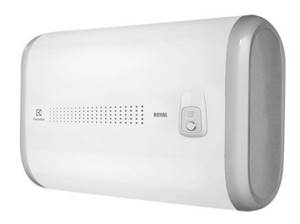
Electrolux EWH 100 Royal
Electrolux NPX6 Aquatronic Digital
A good model in all respects, it is characterized by build quality and high power. An electric heating element in the form of a spiral is installed inside the device. The system is equipped with an electronic display, control system and built-in overheating protection. Water supply is carried out from above.
Main characteristics:
- heating rate 2.8 l/min;
- energy consumption 5.7 kW;
- the pressure created at the exit is 7 atm;
- weight 1.69 kg;
- size 191x141x85 mm.
The average price in the store is 7,550 rubles.
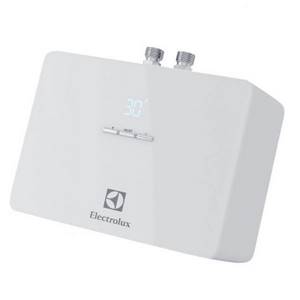
Electrolux NPX6 Aquatronic Digital
Thermex Flat Plus IF 50V
The storage system has an ideal combination of price and quality. The built-in container allows you to collect and heat 50 liters. The manufacturer has provided the boiler with an electronic display and the possibility of electronic control. There are heating and power-on indicators on the tank. The user can set an accelerated heating mode or set a limit on the temperature set. The device has built-in overheating protection, an RCD and a check valve, and a self-cleaning system is provided. The boiler has a modern super-flat shape.
Boiler indicators:
- capacity 50 l;
- consumed electricity 2 kW;
- heating time 80 minutes;
- external data 887x250x436 mm;
- outlet pressure 05, – 6 atm.;
- heating degrees up to 75°C;
- weight 16 kg.
The price in stores is 13,600 rubles.

Thermex Flat Plus IF 50V
Hyundai H-IWR1-3P-CS
The electric flow device has been noted by many customers as a reliable and convenient water heating system. Fashionable design and compact dimensions allow it to be installed in almost any room. The device is equipped with mechanical temperature control and a heating indicator. The device includes a faucet, a shower head and a hose for connecting to it. After purchasing the device, you can easily install it, connect it to the water supply and start using it immediately.
Main characteristics:
- heating up to 85°C;
- heating volume 2.3 l/min;
- water pressure 0.7 – 6 atm;
- current consumption 3.5 kW;
- dimensions 258x153x95 mm;
- weight 1.3 kg.
The average cost in stores is 2,600 rubles.
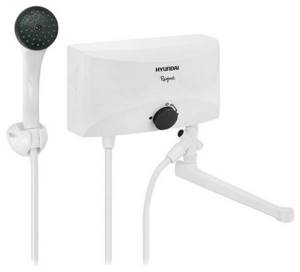
Hyundai H-IWR1-3P-CS
Zanussi 3-logic 3.5 S
A Zanussi brand boiler is considered the best option for those who care about price-quality ratio. The device has built-in protection against use without water and exceeding permissible heating temperatures. The manufacturer included a water filter, a shower head and a hose for connecting it. The system has a low cost and a good volume of water heating per minute.
Main parameters:
- heating rate 3.7 l/min;
- electrical consumption 3.5 kW;
- water outlet pressure 0.7 – 6 atm;
- external data 270x135x100 mm;
- weight 1.5 kg.
The average price in the store is 2300 rubles.
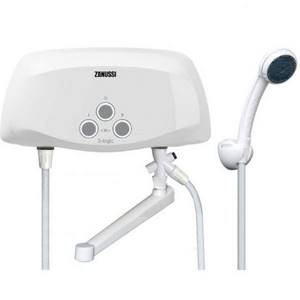
Zanussi 3-logic 3.5 S
Temperature stability
Which is better - a water heater or a boiler - in terms of output temperature stability? Agree that its fluctuations are quite unpleasant when trying to wash dishes and especially take a shower.
| Flow-through | Cumulative |
| With a fixed heating power, the temperature rises relative to the original by a fixed number of degrees. In winter and summer, the water temperature at the same pressure will differ by 10 - 20 C | The outlet water temperature is always constant. It is determined by the manually set position of the thermostat on the boiler body |
I noticed another unpleasant moment in the operation of the flow-through heater. In winter, the temperature of the water inside the water supply located within the heated room differs markedly from the temperature in the water supply main. As a result, after a few minutes of taking a shower, the water suddenly cools down.
Separately, it is worth mentioning the gas flow-through heater (gas water heater). In it, the water temperature is regulated automatically - a bimetallic or digital thermostat. The thermostat is activated when the outlet water temperature drops and increases the burner flame.
However, the rather low accuracy of adjustment and the large inertia of temperature changes make trying to take a shower a constant struggle with the lever or taps of the mixer. As the water pressure increases, the burner ignites and quickly heats the water to an uncomfortably high temperature; when reduced, the water cools just as quickly to ice cold.

Geyser.

